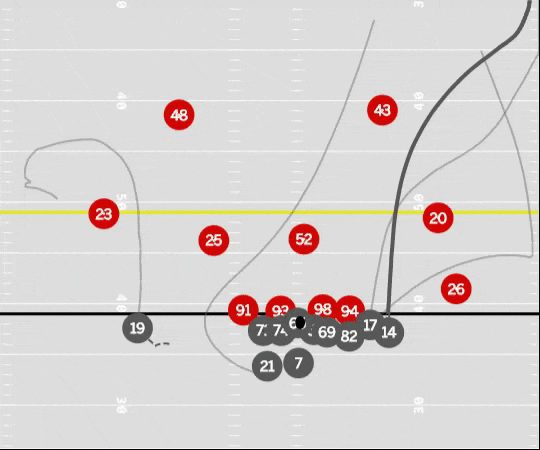There’s something captivating about miracles: the surprise of the unexpected, the awestruck reaction and the lasting impact. Yet they’re often hard to truly comprehend unless you witness them.
Over the past 11 months, the NFL has produced two jaw-dropping miracle plays that grabbed the attention of the sports world. In January, Minnesota Vikings receiver Stefon Diggs starred in the “Minneapolis Miracle,” snatching a playoff victory from the New Orleans Saints‘ grasp. Last Sunday, Miami Dolphins running back Kenyan Drake outran a stumbling Rob Gronkowski as time expired to create the “Miami Miracle” and shock the rival New England Patriots.
Each fan base will argue their “miracle” reigns supreme. ESPN NFL Nation reporters Cameron Wolfe and Courtney Cronin help paint a picture of each memorable play. Now we want you to decide: Which miracle was better?
The Minneapolis Miracle
The situation: Down 24-23 with 10 seconds remaining and a trip to the NFC Championship Game at stake, the Vikings line up on their own 39-yard line on third-and-10 with the chance to run one final play against the Saints in the divisional playoffs. Minnesota has no timeouts left. A miracle is needed for the Vikings to come back, win this game and save their season.
WHAT.
AN.
ENDING!#BringItHome pic.twitter.com/VWakbeWdcL— Minnesota Vikings (@Vikings) January 15, 2018
The play: Case Keenum breaks the huddle with the play “Gun Buffalo Right Key Left 7 Heaven.” The “B” in “Buffalo” signified a 3×1 bunch formation with three receivers to the right of the quarterback (Diggs, Kyle Rudolph and Jarius Wright) and Adam Thielen lines up to Keenum’s left as the X-receiver. All of Keenum’s weapons are instructed to get out of bounds as quickly as they can if they end up on the receiving end of his throw.
Once Keenum sees Thielen getting doubled, he bails on his plan to throw to him. To Keenum’s right, Wright (the F-receiver) is at the point of attack, Rudolph is tasked with running a quick out while Diggs runs a high-angle “seven heaven” (corner route). Minnesota had just run the same play moments before. Once Keenum finds Diggs on the 7-route, he launches the ball to the sideline, later saying he lost vision behind his right guard and couldn’t really see where he was throwing to. But he felt the ball come out of his hand really well. Diggs catches the ball, then Saints rookie safety Marcus Williams whiffs on the tackle and Diggs runs into the end zone for a 61-yard touchdown. The Vikings stun the Saints, capturing a 29-24 victory and a trip to Philadelphia for the NFC title game.
By the numbers: According to NFL Next Gen Stats, Keenum’s throw had a completion probability of 32.2 percent. Diggs, whose max speed on the play was 18.59 mph, had 0.72 yards of separation from his defender when he caught the ball.

What they said: “I’m not going to say I picked out [Diggs] beforehand. But we needed a big chunk. Thielen was on the back side covered. I had to give a guy a chance. I don’t know what the percentage was. I was just trying to give a guy a chance.” — Keenum
“I was thinking, ‘Catch it, get out of bounds and maybe kick a field goal.’ I took a picture before I turned around to catch the ball. There was only one guy there. If he slipped, then I was going to try to stay up and keep it going … I was preparing for somebody to contact me so I could go out of bounds, but nobody contacted me. I kind of lost my footing a little bit. I just tried to gather myself with my hand. My hand never let me down. Just tried to gather myself, and the rest is history.” — Diggs
The Miami Miracle
The situation: The Dolphins are down 33-28 with seven seconds left in a back-and-forth contest with the Patriots. A loss looks imminent as the Dolphins have the ball on their own 31-yard line with enough time for one last-ditch play to keep their playoff hopes alive and prevent New England from clinching a 10th straight AFC East title.
IT’S A MIAMI MIRACLE! 😱😱😱 #FinsUp#NEvsMIA pic.twitter.com/qvzsiI9a5g
— NFL (@NFL) December 9, 2018
The play: Adam Gase calls for “Boise,” their go-to, end-of-game, hook-and-lateral play. Ryan Tannehill completes a 16-yard pass to Kenny Stills, whose job is to pitch the ball to nearby receiver DeVante Parker. Stills’ decision to hold the ball a second longer and make a defender miss before pitching the ball to Parker helps make the play. Parker quickly pitches the ball to a trailing Drake, who said it was “sandlot football” after that. The last few seconds of the play were the most memorable. Patriots tight end Rob Gronkowski, curiously inserted by Bill Belichick to defend a would-be 70-plus-yard Hail Mary, is the last man there to stop Drake. Gronkowski, looking uncomfortable playing just his second defensive snap of the season, trips over the grass and tumbles to the ground as Drake speeds across the goal line.
By the numbers: Drake ran 97.96 total yards on the play (the farthest distance of anyone on the field) and hit a max speed of 18.70 mph. Patriots defenders J.C. Jackson (19.86 mph) and Kyle Van Noy (19.13 mph) had the two fastest speeds on the field during the play.
Ryan Tannehill-Kenny Stills-DaVante Parker-Kenyan Drake. @MiamiDolphins win.#NEvsMIA #FinsUp pic.twitter.com/TxhamyDcSs
— Next Gen Stats (@NextGenStats) December 9, 2018
What they said: “I couldn’t let Gronk tackle me in that situation. Look, sorry, Gronk, you’re a great player, but I’ve got somewhere to be.” — Drake
“I was looking to make a block — that way they wouldn’t throw me the ball.” — Dolphins guard Ted Larsen, who ran 40 yards downfield to make the defining block of the play on Patrick Chung at the Patriots’ 30-yard line.
Which play was better?
“That’s tough. I’d say the thing that probably amped theirs up even more was the fact that it was a playoff game. Just being in those … With my experience of being in the playoffs, those games are so intense and the emotional swings are so great. I can’t even imagine how that felt after that.” — Dolphins coach Adam Gase


